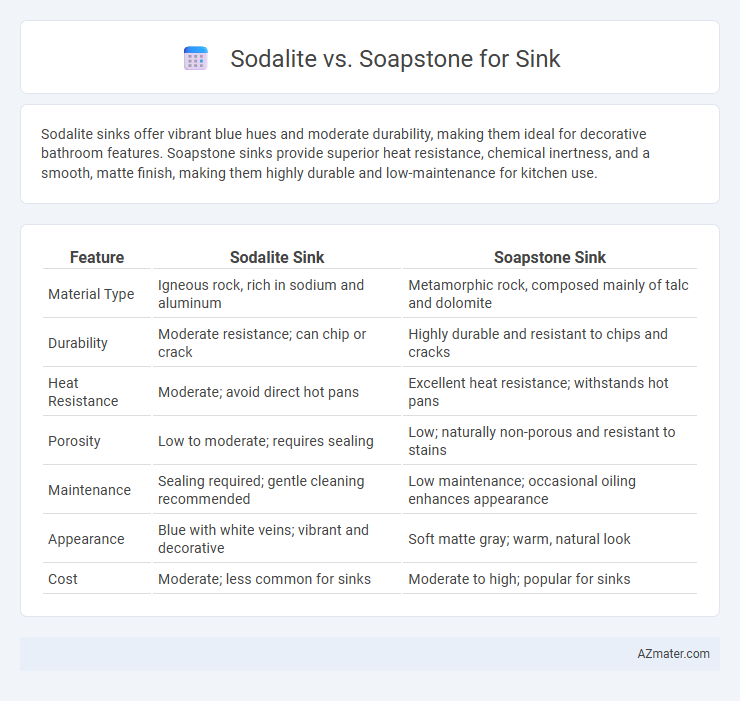Sodalite sinks offer vibrant blue hues and moderate durability, making them ideal for decorative bathroom features. Soapstone sinks provide superior heat resistance, chemical inertness, and a smooth, matte finish, making them highly durable and low-maintenance for kitchen use.
Table of Comparison
| Feature | Sodalite Sink | Soapstone Sink |
|---|---|---|
| Material Type | Igneous rock, rich in sodium and aluminum | Metamorphic rock, composed mainly of talc and dolomite |
| Durability | Moderate resistance; can chip or crack | Highly durable and resistant to chips and cracks |
| Heat Resistance | Moderate; avoid direct hot pans | Excellent heat resistance; withstands hot pans |
| Porosity | Low to moderate; requires sealing | Low; naturally non-porous and resistant to stains |
| Maintenance | Sealing required; gentle cleaning recommended | Low maintenance; occasional oiling enhances appearance |
| Appearance | Blue with white veins; vibrant and decorative | Soft matte gray; warm, natural look |
| Cost | Moderate; less common for sinks | Moderate to high; popular for sinks |
Introduction to Sodalite and Soapstone Sinks
Sodalite sinks are crafted from a vibrant, blue-hued mineral known for its rich color and decorative appeal, adding a unique focal point to bathroom and kitchen designs. Soapstone sinks, made from a dense, non-porous metamorphic rock, offer exceptional durability and resistance to heat and stains, making them practical for everyday use. Both materials provide distinctive aesthetic and functional benefits, with sodalite appealing for its striking appearance and soapstone favored for its robustness and ease of maintenance.
Visual Appeal: Color and Pattern Comparison
Sodalite sinks feature deep blue hues with striking white veining, creating a bold, vibrant visual impact ideal for modern or eclectic kitchen designs. Soapstone offers more muted, soft gray tones with subtle veining that ages gracefully, providing a timeless and natural look well-suited for rustic or traditional spaces. The choice between sodalite and soapstone depends on whether a dramatic or understated aesthetic best complements the overall sink and countertop environment.
Material Composition and Origins
Sodalite, a deep-blue mineral primarily composed of sodium aluminum silicate, originates mainly from igneous rock formations found in Brazil, Canada, and Russia, offering vibrant color and moderate durability for sinks. Soapstone, composed predominantly of talc with magnesium carbonate, is sourced from metamorphic regions such as the United States, Brazil, and India, prized for its softness, heat resistance, and chemical inertness in sink applications. The contrasting mineral compositions define their performance characteristics, with sodalite providing aesthetic appeal and soapstone delivering superior heat and stain resistance for kitchen and bathroom sinks.
Durability and Longevity
Sodalite offers high durability with its dense mineral composition, making it resistant to scratches and heat, ideal for long-lasting kitchen sinks. Soapstone, while softer, provides excellent resistance to stains and chips through its natural talc-rich structure, maintaining longevity with proper sealing and care. Both materials offer impressive lifespan, but sodalite generally outperforms soapstone in hardness and durability for sink applications.
Maintenance and Cleaning Needs
Sodalite sinks require gentle cleaning with mild soap and water to prevent surface damage and maintain their vibrant blue color, while avoiding abrasive cleaners that can cause dullness. Soapstone sinks are highly resistant to stains and scratches; regular cleaning with soft cloths and mineral oil enhances their natural patina and durability. Both materials benefit from routine maintenance but soapstone's non-porous nature means it generally demands less frequent sealing and is more forgiving to everyday wear.
Resistance to Stains, Scratches, and Heat
Sodalite sinks exhibit moderate resistance to stains and scratches but are more vulnerable to heat damage due to their mineral composition. Soapstone, composed primarily of talc, boasts excellent resistance to stains, scratches, and heat, making it highly durable for kitchen and bathroom sinks. Its non-porous surface resists water absorption and withstands high temperatures without cracking or discoloration.
Cost Differences and Budget Considerations
Sodalite sinks generally cost more than soapstone due to their rarity and unique deep blue coloration, with prices often ranging from $150 to $250 per square foot compared to soapstone's $70 to $120 per square foot. Soapstone offers a more budget-friendly option while providing excellent durability and heat resistance, making it ideal for cost-conscious homeowners seeking natural stone sinks. When considering long-term investment, soapstone's lower maintenance costs and wide availability contribute to better overall affordability.
Installation Process and Compatibility
Sodalite sinks require professional installation due to their brittleness and weight, often needing reinforced cabinetry for proper support, while soapstone sinks offer easier handling and can be installed with standard cabinetry because of their uniform density and durability. Both materials are compatible with common plumbing fixtures, but soapstone's non-porous surface allows for seamless integration with undermount or drop-in installation styles, minimizing the risk of leaks. Choosing between sodalite and soapstone depends on balancing aesthetic preference with the practical considerations of installation complexity and long-term compatibility with kitchen or bathroom fixtures.
Environmental Impact and Sustainability
Sodalite and soapstone both offer unique environmental benefits for sinks; sodalite is a naturally occurring mineral with limited supply but requires less processing, reducing its carbon footprint. Soapstone is highly durable and non-porous, extending sink lifespan and minimizing the need for replacements, contributing to sustainability. Choosing soapstone supports eco-friendly practices due to its easy recyclability and lower environmental impact from quarrying compared to sodalite.
Choosing the Best Sink Material: Sodalite vs Soapstone
Sodalite offers a vibrant blue hue and superior hardness, making it resistant to scratches and stains, ideal for high-traffic kitchen sinks. Soapstone, known for its smooth texture and heat resistance, naturally develops a unique patina over time, adding character to bathroom or kitchen sinks. Choosing between sodalite and soapstone depends on desired aesthetics and maintenance preferences, with sodalite excelling in durability and bold color, while soapstone provides a softer, classic look with effortless upkeep.

Infographic: Sodalite vs Soapstone for Sink
 azmater.com
azmater.com